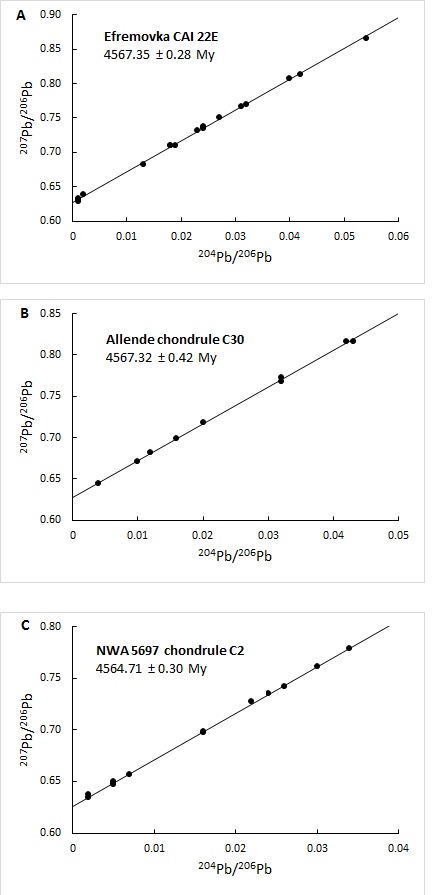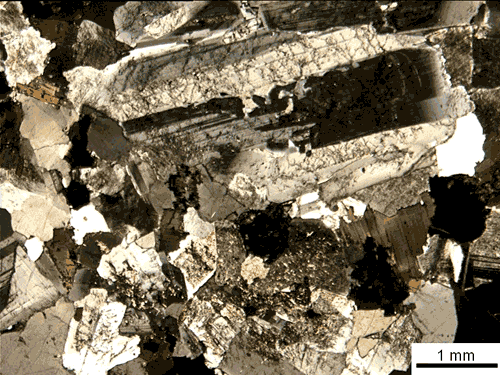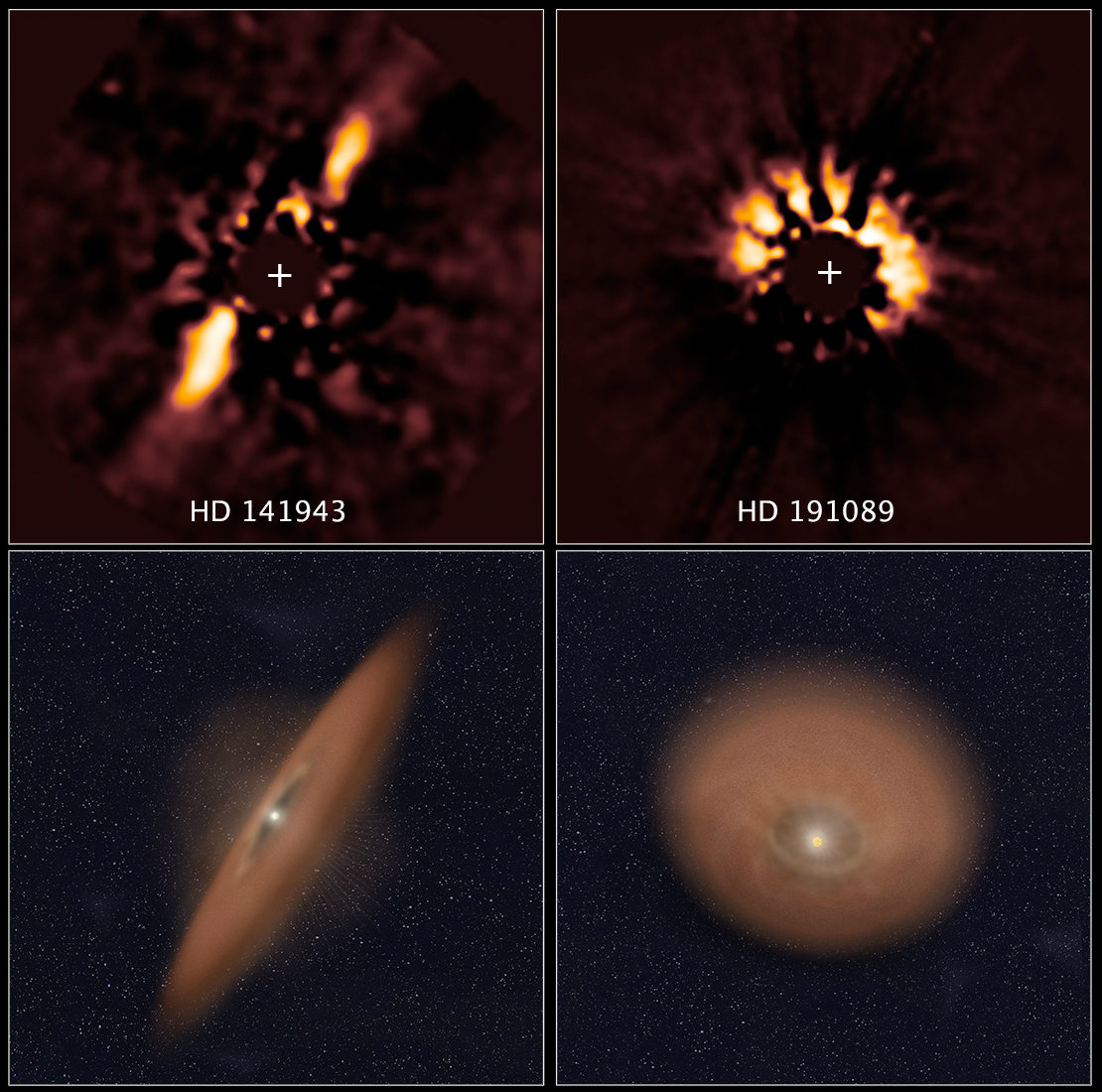|
Lead–lead Dating
Lead–lead dating is a method for dating geological samples, normally based on 'whole-rock' samples of material such as granite. For most dating requirements it has been superseded by uranium–lead dating (U–Pb dating), but in certain specialized situations (such as dating meteorites and the age of the Earth) it is more important than U–Pb dating. Decay equations for common Pb–Pb dating There are three stable "daughter" Pb isotopes that result from the radioactive decay of uranium and thorium in nature; they are 206Pb, 207Pb, and 208Pb. 204Pb is the only non- radiogenic lead isotope, therefore is not one of the daughter isotopes. These daughter isotopes are the final decay products of U and Th radioactive decay chains beginning from 238U, 235U and 232Th respectively. With the progress of time, the final decay product accumulates as the parent isotope decays at a constant rate. This shifts the ratio of radiogenic Pb versus non-radiogenic 204Pb (207Pb/204Pb or 206Pb/204Pb) in ... [...More Info...] [...Related Items...] OR: [Wikipedia] [Google] [Baidu] |
Chronological Dating
Chronological dating, or simply dating, is the process of attributing to an object or event a date in the past, allowing such object or event to be located in a previously established chronology. This usually requires what is commonly known as a "dating method". Several dating methods exist, depending on different criteria and techniques, and some very well known examples of disciplines using such techniques are, for example, history, archaeology, geology, paleontology, astronomy and even forensic science, since in the latter it is sometimes necessary to investigate the moment in the past during which the death of a cadaver occurred. These methods are typically identified as absolute, which involves a specified date or date range, or relative, which refers to dating which places artifacts or events on a timeline relative to other events and/or artifacts. Other markers can help place an artifact or event in a chronology, such as nearby writings and stratigraphic markers. Absolut ... [...More Info...] [...Related Items...] OR: [Wikipedia] [Google] [Baidu] |
Granite
Granite () is a coarse-grained ( phaneritic) intrusive igneous rock composed mostly of quartz, alkali feldspar, and plagioclase. It forms from magma with a high content of silica and alkali metal oxides that slowly cools and solidifies underground. It is common in the continental crust of Earth, where it is found in igneous intrusions. These range in size from dikes only a few centimeters across to batholiths exposed over hundreds of square kilometers. Granite is typical of a larger family of ''granitic rocks'', or '' granitoids'', that are composed mostly of coarse-grained quartz and feldspars in varying proportions. These rocks are classified by the relative percentages of quartz, alkali feldspar, and plagioclase (the QAPF classification), with true granite representing granitic rocks rich in quartz and alkali feldspar. Most granitic rocks also contain mica or amphibole minerals, though a few (known as leucogranites) contain almost no dark minerals. Granite is ... [...More Info...] [...Related Items...] OR: [Wikipedia] [Google] [Baidu] |
Uranium–lead Dating
Uranium–lead dating, abbreviated U–Pb dating, is one of the oldest and most refined of the radiometric dating schemes. It can be used to date rocks that formed and crystallised from about 1 million years to over 4.5 billion years ago with routine precisions in the 0.1–1 percent range. The method is usually applied to zircon. This mineral incorporates uranium and thorium atoms into its crystal structure, but strongly rejects lead when forming. As a result, newly-formed zircon deposits will contain no lead, meaning that any lead found in the mineral is radiogenic. Since the exact rate at which uranium decays into lead is known, the current ratio of lead to uranium in a sample of the mineral can be used to reliably determine its age. The method relies on two separate decay chains, the uranium series from 238U to 206Pb, with a half-life of 4.47 billion years and the actinium series from 235U to 207Pb, with a half-life of 710 million years. Decay routes Uranium decays to lead v ... [...More Info...] [...Related Items...] OR: [Wikipedia] [Google] [Baidu] |
Age Of The Earth
The age of Earth is estimated to be 4.54 ± 0.05 billion years This age may represent the age of Earth's accretion, or core formation, or of the material from which Earth formed. This dating is based on evidence from radiometric age-dating of meteorite material and is consistent with the radiometric ages of the oldest-known terrestrial and lunar samples. Following the development of radiometric age-dating in the early 20th century, measurements of lead in uranium-rich minerals showed that some were in excess of a billion years old.For the abstract, see: The oldest such minerals analyzed to date—small crystals of zircon from the Jack Hills of Western Australia—are at least 4.404 billion years old. Calcium–aluminium-rich inclusions—the oldest known solid constituents within meteorites that are formed within the Solar System—are 4.567 billion years old, giving a lower limit for the age of the Solar System. It is hypothesised that the accretion of Earth began soon ... [...More Info...] [...Related Items...] OR: [Wikipedia] [Google] [Baidu] |
Radiogenic Nuclide
A radiogenic nuclide is a nuclide that is produced by a process of radioactive decay. It may itself be radioactive (a radionuclide) or stable (a stable nuclide). Radiogenic nuclides (more commonly referred to as radiogenic isotopes) form some of the most important tools in geology. They are used in two principal ways: #In comparison with the quantity of the radioactive 'parent isotope' in a system, the quantity of the radiogenic 'daughter product' is used as a radiometric dating tool (e.g. uranium–lead geochronology). #In comparison with the quantity of a non-radiogenic isotope of the same element, the quantity of the radiogenic isotope is used to define its isotopic signature (e.g. 206Pb/204Pb). This technique is discussed in more detail under the heading isotope geochemistry. Examples Some naturally occurring isotopes are entirely radiogenic, but all these are isotopes that are radioactive, with half-lives too short to occur primordially. Thus, they are only present as ... [...More Info...] [...Related Items...] OR: [Wikipedia] [Google] [Baidu] |
Clair Cameron Patterson
Clair Cameron Patterson (June 2, 1922 – December 5, 1995) was an American geochemist. Born in Mitchellville, Iowa, Patterson graduated from Grinnell College. He later received his Ph.D. from the University of Chicago and spent his entire professional career at the California Institute of Technology (Caltech). In collaboration with George Tilton, Patterson developed the uranium–lead dating method into lead–lead dating. By using lead isotopic data from the Canyon Diablo meteorite, he calculated an age for the Earth of 4.55 billion years, which was a figure far more accurate than those that existed at the time, and one that has remained largely unchanged since 1956. Patterson first encountered lead contamination in the late 1940s as a graduate student at the University of Chicago. His work on this subject led to a total re-evaluation of the growth in industrial lead concentrations in the atmosphere and the human body, and his subsequent campaigning was seminal in the bann ... [...More Info...] [...Related Items...] OR: [Wikipedia] [Google] [Baidu] |
Planetesimal
Planetesimals are solid objects thought to exist in protoplanetary disks and debris disks. Per the Chamberlin–Moulton planetesimal hypothesis, they are believed to form out of cosmic dust grains. Believed to have formed in the Solar System about 4.6 billion years ago, they aid study of its formation. Formation A widely accepted theory of planet formation, the so-called planetesimal hypotheses, the Chamberlin–Moulton planetesimal hypothesis and that of Viktor Safronov, states that planets form from cosmic dust grains that collide and stick to form ever-larger bodies. Once a body reaches around a kilometer in size, its constituent grains can attract each other directly through mutual gravity, enormously aiding further growth into moon-sized protoplanets. Smaller bodies must instead rely on Brownian motion or turbulence to cause the collisions leading to sticking. The mechanics of collisions and mechanisms of sticking are intricate. Alternatively, planetesimals may for ... [...More Info...] [...Related Items...] OR: [Wikipedia] [Google] [Baidu] |
Canyon Diablo (meteorite)
The Canyon Diablo meteorite refers to the many fragments of the asteroid that created Meteor Crater (also called Barringer Crater), Arizona, United States. Meteorites have been found around the crater rim, and are named for nearby Canyon Diablo, which lies about three to four miles west of the crater. History The impactor fell about 50,000 years ago. Initially known and used by pre-historic Native Americans, Canyon Diablo meteorites have been collected and studied by the scientific community since the 19th century. Meteor Crater, from the late 19th to the early 20th century, was the center of a long dispute over the origin of craters that showed little evidence of volcanism. That debate was largely settled by the early 1930s, thanks to work by Daniel M. Barringer, F.R. Moulton, Harvey Harlow Nininger, and Eugene Shoemaker. In 1953, Clair Cameron Patterson measured ratios of the lead isotopes in samples of the meteorite. Through U-Pb radiometric dating, a refined estima ... [...More Info...] [...Related Items...] OR: [Wikipedia] [Google] [Baidu] |
Canyon Diablo (canyon)
Canyon Diablo (Navajo: Kin Łigaaí) is a canyon near Two Guns in Northern Arizona. Part of it is located on the Navajo Nation. Discovery Canyon Diablo was named by U.S. Army Lieutenant Amiel Weeks Whipple. Whipple, of the Army's Topographical Engineers, made a survey in 1853–1854 along the 35th parallel. In mid December 1853 Whipple found a steep canyon while riding west from a point near Winslow with a reconnaissance party. He named it Canyon Diablo. The canyon passes west of Meteor Crater. The community of Canyon Diablo, Arizona on the edge of the canyon about northwest of the crater was the closest community to the crater when scientists began investigating the crater. Consequently, the meteorite that caused the crater is officially called the Canyon Diablo meteorite. Canyon Diablo ("devil canyon") is the Spanish translation of the Native American name. The Canyon Diablo Bridge Canyon Diablo Bridge is an abandoned automobile bridge in Coconino County, Ar ... [...More Info...] [...Related Items...] OR: [Wikipedia] [Google] [Baidu] |
Meteor Crater
Meteor Crater, or Barringer Crater, is a meteorite impact crater about east of Flagstaff and west of Winslow in the desert of northern Arizona, United States. The site had several earlier names, and fragments of the meteorite are officially called the Canyon Diablo Meteorite, after the adjacent Cañon Diablo. Because the United States Board on Geographic Names recognizes names of natural features derived from the nearest post office, the feature acquired the name of "Meteor Crater" from the nearby post office named Meteor. Meteor Crater lies at an elevation of above sea level. It is about in diameter, some deep, and is surrounded by a rim that rises above the surrounding plains. The center of the crater is filled with of rubble lying above crater bedrock. One of the interesting features of the crater is its squared-off outline, believed to be caused by existing regional jointing (cracks) in the strata at the impact site. Despite historic attempts to make the crater ... [...More Info...] [...Related Items...] OR: [Wikipedia] [Google] [Baidu] |
Paterson Isochron Animation
Paterson may refer to: People *Paterson (surname) *Paterson (given name) Places Australia *Paterson, New South Wales *Paterson River, New South Wales *Division of Paterson, an electoral district in New South Wales * Paterson, Queensland, a locality in the Fraser Coast Region, Queensland * Electoral division of Paterson, an electoral district in Tasmania United States *Paterson, New Jersey * Paterson, Washington Elsewhere *Mount Paterson (Antarctica) *Mount Paterson, South Georgia *Paterson, Eastern Cape, South Africa *Paterson Inlet, New Zealand *Paterson Island, a sandspit off of Morrich More, Scotland *Paterson Street, Hong Kong Other uses * Paterson (automobile), a car built by the W. A. Paterson Company from 1909-23 * ''Paterson'' (film), a 2016 drama starring Adam Driver * ''Paterson'' (poem), by American poet William Carlos Williams *Colt Paterson, the first revolver See also * Patterson (other) * Pattison (other) Pattison may refer to: *Pattison, Mis ... [...More Info...] [...Related Items...] OR: [Wikipedia] [Google] [Baidu] |



.jpg)


